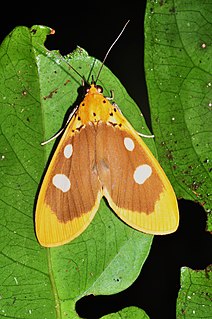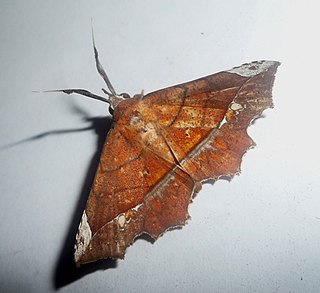
Oxytenis is a genus of moths in the family Saturniidae and subfamily Oxyteninae. The genus was erected by Jacob Hübner in 1819. During its larval form, it has large eyespots on the front of its head in an attempt to mimic a snake. The larva has unusual, large, almost wing-like, fleshy protrusions on either side.

Eumorpha anchemolus, the anchemola sphinx moth, is a moth of the family Sphingidae. The species was first described by Pieter Cramer in 1780.

Daphnis hypothous, the jade hawkmoth, is a moth of the family Sphingidae described by Pieter Cramer in 1780. It is known from Sri Lanka, southern and northern India, Nepal, Myanmar, southern China, Taiwan, Thailand, Malaysia, and Indonesia. It is a rare vagrant to the Western Palaearctic realm. During the last hundred years a number have been discovered within the Middle East and one was even found in Scotland late in the 20th century but this was probably imported as a pupa with cargo.

Syntomoides imaon, the handmaiden moth, is a moth of subfamily Arctiinae, subtribe Ctenuchina. The systematics of the subfamily has been revised. It was described by Pieter Cramer in 1780. It is well distributed in Sikkim, Khasi hills and throughout India Kerala, Sri Lanka, Myanmar, Bangladesh and Hong Kong, Viet Nam.

Phigalia titea, the spiny looper or half-wing moth, is a species of moth in the family Geometridae. The species was first described by Pieter Cramer in 1780. The average wingspan is about 34 mm.

Eudocima is a genus of moths of the family Erebidae first described by Gustaf Johan Billberg in 1820.

Gonodonta is a genus of moths in the family Erebidae. The genus was erected by Jacob Hübner in 1818.

Catocala ilia, the Ilia underwing, beloved underwing or wife underwing, is a moth of the family Erebidae. The species was first described by Pieter Cramer in 1776. It can be found in the eastern part of the United States as well as southern Canada. Subspecies Catocala ilia zoe can be found in California and Arizona.

Hulodes caranea is a species of moth of the family Erebidae first described by Pieter Cramer in 1780. It is found from India, Sri Lanka, Myanmar, Java, Hong Kong to Queensland and New Guinea, it is also found on the Marianas and Carolines.

Sphinx gordius, the apple sphinx, is a moth of the family Sphingidae. The species was first described by Pieter Cramer in 1780.

Catocala grynea, the woody underwing, is a moth of the family Erebidae. The species was first described by Pieter Cramer in 1780. It is found in North America from Ontario and Quebec through Maine and Connecticut, south to Florida, west to Texas and north through Iowa to Wisconsin and Minnesota.

Asota javana is a moth of the family Erebidae first described by Pieter Cramer in 1780. It is found in Sundaland, the Philippines, Sulawesi and on Sula Island.

Platyja umminia is a species of moth of the family Noctuidae first described by Pieter Cramer in 1780. It is found from the Indo-Australian tropics of China, Japan, India, Sri Lanka, Myanmar to New Guinea and Queensland. It is also present on Guam. Adults have been recorded piercing fruit in Thailand and Guam.

Ametris nitocris, the seagrape spanworm moth, is a moth of the family Geometridae. The species was first described by Pieter Cramer in 1780. It is found from the southern United States through Central America to South America. It is also found on the Antilles.
Amerila vidua is a moth of the subfamily Arctiinae. It was described by Pieter Cramer in 1780. It is found in Cameroon, Democratic Republic of the Congo, Equatorial Guinea, Ethiopia, Ghana, Guinea, Ivory Coast, Kenya, Mauritius, Nigeria, Sierra Leone and Tanzania.

Lacera alope, the toothed drab, is a moth of the family Erebidae. The species was first described by Pieter Cramer in 1780. It is found in Africa, where it is known from southern and eastern Africa, including several islands of the Indian Ocean, Saudi Arabia, and southern Asia from India, Sri Lanka to China.
Nausinoe pueritia is a moth in the family Crambidae. It was described by Pieter Cramer in 1780. It is found in India, Sri Lanka, Burma, Malaysia, Thailand and Australia, where it has been recorded from the Northern Territory, Queensland and New South Wales.

Cydosia nobilitella, the curve-lined cydosia moth or regal cydosia moth, is a moth of the family Noctuidae. The species was first described by Pieter Cramer in 1779. It is found from southern Florida south to Argentina. It is also found on the Antilles.

Syllectra erycata is a moth in the family Erebidae first described by Pieter Cramer in 1780. It is found from Florida, Texas and the Antilles to Brazil, Peru, Suriname and Bolivia.

Gonodontis clelia is a moth in the family Geometridae first described by Pieter Cramer in 1780. It is found in Sri Lanka, South India, Pakistan, Nepal, Hong Kong, the Andaman Islands, Singapore, Borneo and Australia.


















